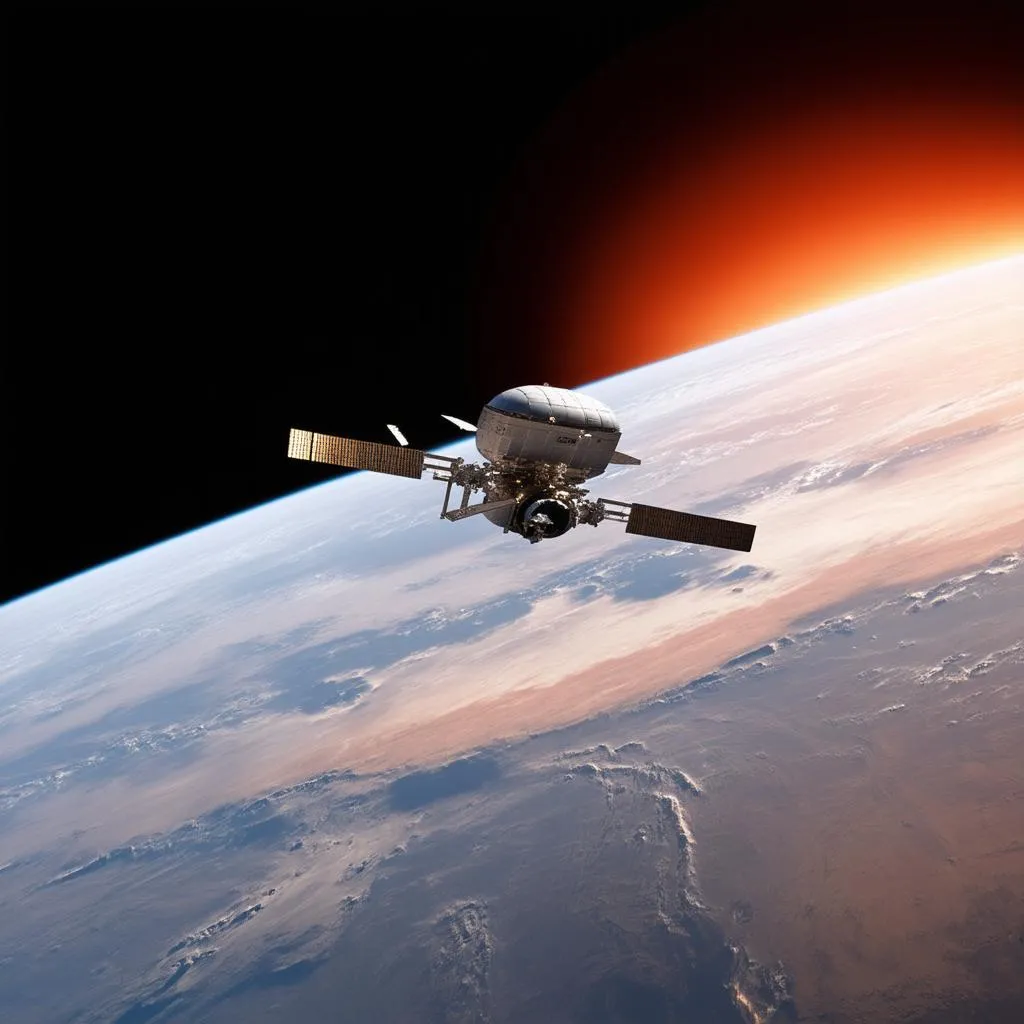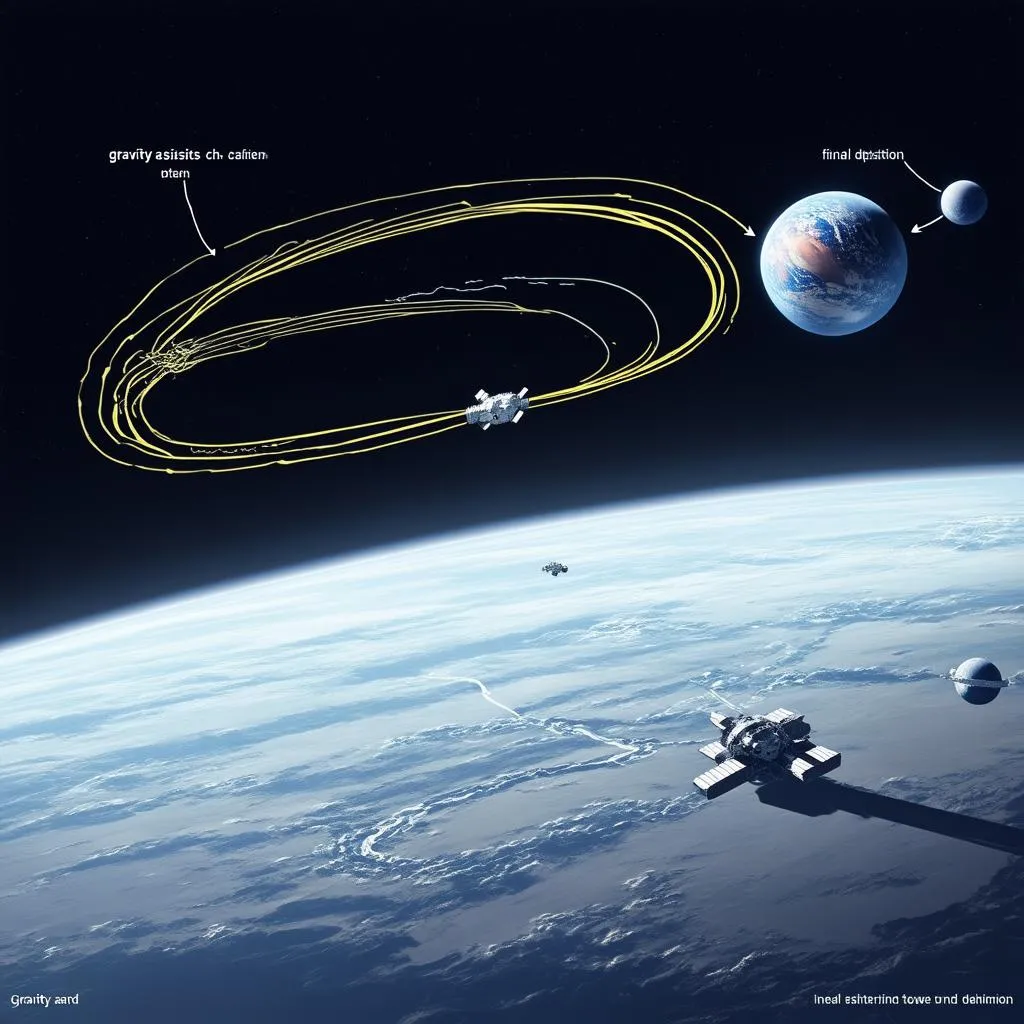Have you ever watched a tennis ball whiz off a moving racket and gain extra speed? That’s a bit like how gravity assists work in space travel. Instead of a racket, we use the gravitational pull of planets to “slingshot” spacecraft, altering their speed and trajectory. This clever technique has allowed us to explore the far reaches of our solar system, from Jupiter’s swirling storms to Pluto’s icy plains. But are gravity assists always the best option for space travel? Let’s dive in and find out!
Understanding Gravity Assists: A Cosmic Dance
Imagine a spacecraft approaching a planet like Jupiter. As it gets closer, the planet’s immense gravity pulls the spacecraft in, increasing its speed. Now, if the spacecraft simply flew past Jupiter, it would eventually slow down as it moves away, losing all the gained velocity. The trick lies in using the planet’s motion.
As the planet orbits the sun, it carries with it a “gravity well” – a region of space where its gravitational influence dominates. By carefully planning the trajectory, the spacecraft can essentially “steal” some of the planet’s orbital energy as it enters and exits this gravity well. This exchange of momentum boosts the spacecraft’s speed relative to the sun, without using any extra fuel!
The Pros of Gravity Assists: Why They’re So Nifty
Gravity assists offer numerous advantages:
- Fuel Efficiency: The most significant benefit is saving precious fuel. Launching payloads into space is incredibly expensive, so minimizing fuel consumption is crucial, especially for long-duration missions.
- Increased Payload Capacity: With less fuel needed for propulsion, spacecraft can carry more scientific instruments, experiments, and even rovers!
- Exploring Distant Targets: Gravity assists enable us to reach destinations that would otherwise be extremely challenging or even impossible with our current technology. For example, the Voyager missions wouldn’t have been able to visit the outer planets without multiple gravity assists.
 Voyager spacecraft
Voyager spacecraft
The Cons: It’s Not Always a Smooth Ride
While gravity assists are powerful tools, they come with limitations:
- Trajectory Constraints: Aligning a spacecraft for a perfect gravity assist requires intricate calculations and precise timing. Sometimes, the desired trajectory might not align with the positions of planets, limiting mission opportunities.
- Mission Duration: Depending on the desired trajectory, using gravity assists can significantly extend the mission duration, sometimes by years!
- Limited Opportunities: Not all planets are ideal for gravity assists. Factors like mass, orbital speed, and relative position to the target all play a role in determining the effectiveness of a gravity assist maneuver.
Planning a Mission: When are Gravity Assists the Best Choice?
Deciding whether to use a gravity assist involves a careful analysis of various factors:
- Mission Objectives: What are the scientific goals of the mission? Where are we trying to reach, and what do we hope to learn?
- Technological Constraints: How much fuel can we afford to carry? What is the maximum duration for the mission?
- Planetary Alignments: Are there any planets in favorable positions to provide a gravity assist within our timeframe?
For instance, a mission to study a comet might prioritize speed over fuel efficiency, favoring a direct trajectory. However, a mission to a distant planet like Neptune might benefit greatly from the fuel savings offered by a gravity assist, even if it means a longer journey.
 Spacecraft Trajectory
Spacecraft Trajectory
FAQs: Answering Your Burning Questions
- Q: Do gravity assists violate the laws of physics? No, gravity assists cleverly utilize the existing laws of physics, specifically the conservation of momentum and energy.
- Q: How fast can a spacecraft go using a gravity assist? The speed gain depends on the planet’s mass and orbital speed. For example, a spacecraft can gain up to 13 kilometers per second from a Jupiter gravity assist.
- Q: Are gravity assists used for missions beyond our solar system? While we haven’t sent any spacecraft beyond our solar system yet, future interstellar missions might use the sun’s gravity for a significant speed boost.
Exploring the Cosmos: Gravity Assists and Beyond
Gravity assists have revolutionized our ability to explore the cosmos. From the iconic images of Jupiter’s Great Red Spot captured by Voyager to the breathtaking views of Pluto’s icy heart sent back by New Horizons, these maneuvers have allowed us to push the boundaries of space exploration.
As we continue to develop new technologies and unravel the mysteries of the universe, gravity assists will undoubtedly remain invaluable tools in our quest to understand the vast expanse beyond our planet.
If you’re intrigued by the wonders of space travel and want to delve deeper into topics like interplanetary trajectories and mission planning, be sure to check out our other articles on TRAVELCAR.edu.vn. We’re passionate about sharing the excitement of space exploration with everyone!

